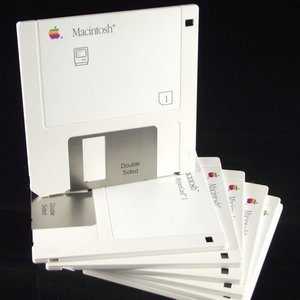
|
This site is running on a 286 PC, booted and served
entirely from a 90mm floppy disk. See current
server stats. All content on this site is provided by the Museum of Obsolete Media, curated by Jason Curtis. My sincerest thanks to Jason for providing me with the worthy challenge of exhibiting his work in the only appropriate way: The Floppy Disk Museum: The Bootable Floppy edition! |


The 3.5-inch microfloppy disk was a magnetic disk format for data storage, originally introduced by Sony in 1981. An improved design was introduced by the Microfloppy Industry Committee in 1982, with a single-sided double-density (SS/DD) disk and a formatted capacity of 360 KB in IBM-compatible PCs (400 KB in Apple Macintosh PCs). The double-sided/double-density (DS/DD) disk was introduced in 1984 with a formatted capacity in IBM-compatible PCs of 720 KB.
High Density (HD) 1.44 MB disks, recognisable by a second hole in the opposite corner to the write-protect notch and a HD logo, were introduced later, in 1987
The 3.5-inch disk was housed in a semi-rigid case, with a metal shutter to protect the disk. Because they were not quite square it was impossible to insert a disk the wrong way round.
Their formatted capacity of a double-sided disk varied. For example, in IBM-compatible PCs and the Atari ST the formatted capacity was 720 KB, but in Apple Macintosh PCs this was increased to 800 KB by varying the rotational speed with the head position. In the Commodore 1581 disk drive, a DS/DD floppy could be formatted with a capacity of 800 KB, and and in AmigaOS a disk could be formatted with a capacity of 880 KB.
Once introduced, the 3.5-inch HD (High Density) microfloppy quickly become widely used on PC and Macintosh computers, but HD drives could read DS/DD media.
Dimensions: 94 mm * 90 mm * 3.3 mm
Capacity: 360 KB to 720 KB (400 KB to 800 KB when formatted for Macintosh computers)